
How many surrealists does it take to change a light bulb?
Fish.
Fish.
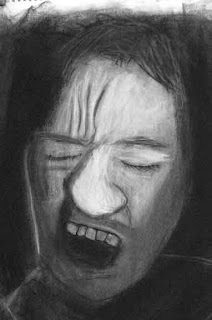 The first of today’s in-class exercises was kind of a weird one I started using years ago as a tool to accomplish two main goals; one being how to use the subtractive technique for creating a full range of values to give shapes volume in space (in other words, using an eraser as a drawing tool with charcoal); the second, sneaking in an underhanded introduction to self-portraits, which many beginners view, along with figure drawing in general, with some trepidation. Additionally, this assignment is a perfect bonus opportunity to flog the whole “pushing the values” mantra, and to also not be so damned hung up on creating an exact copy of the subject matter before them. And that would be a photocopy of their face smushed up against the glass - I take small groups at a time into the art department office and program in the best settings (photo + sharpness all the way down + a couple levels darker + tabloid paper in the bypass tray) and have them go face-down on the copier while I push the buttons. Needless to say this sometimes takes a bit of coaxing on the part of some of the more fastidious or reserved students, but eventually I get something workable out of everyone.
The first of today’s in-class exercises was kind of a weird one I started using years ago as a tool to accomplish two main goals; one being how to use the subtractive technique for creating a full range of values to give shapes volume in space (in other words, using an eraser as a drawing tool with charcoal); the second, sneaking in an underhanded introduction to self-portraits, which many beginners view, along with figure drawing in general, with some trepidation. Additionally, this assignment is a perfect bonus opportunity to flog the whole “pushing the values” mantra, and to also not be so damned hung up on creating an exact copy of the subject matter before them. And that would be a photocopy of their face smushed up against the glass - I take small groups at a time into the art department office and program in the best settings (photo + sharpness all the way down + a couple levels darker + tabloid paper in the bypass tray) and have them go face-down on the copier while I push the buttons. Needless to say this sometimes takes a bit of coaxing on the part of some of the more fastidious or reserved students, but eventually I get something workable out of everyone. Then its back to the classroom and a demo on how to prep the drawing paper with a neutral base tone, say about a 30% gray, using the long edge of a chunk of charcoal in tangent with a wad of toilet paper. Once that stage is done, using alternating strokes of the charcoal and an eraser I begin to block out large areas, first with sketched lines, then blobs of value, gradually refining as I go, along with constant smearing with the wad.
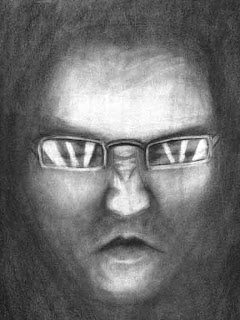
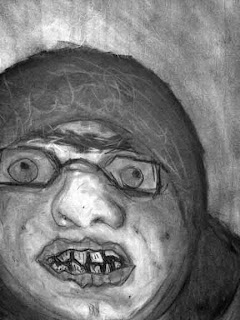 Sort of similar to kneading bread (not that many of them have ever done that), eventually something vaguely resembling a face begins to emerge from the darkness, and using the photocopy as a rough guide, they can begin to tighten it up with the judicious and appropriate application of detailed marks.
Sort of similar to kneading bread (not that many of them have ever done that), eventually something vaguely resembling a face begins to emerge from the darkness, and using the photocopy as a rough guide, they can begin to tighten it up with the judicious and appropriate application of detailed marks.This is a very forgiving and malleable project, as at any point mistakes can be simply obliterated and modified by adding or subtracting more charcoal. And again I reiterate that I’m ultimately more concerned with the building up of a full range of shading, from deep, rich darks to the highlights, with smooth transitional gradations in between, to really give a sense of volume and depth to the image. Which, by the time they’re done, should be either a horrifying portrayal of their inner anguish at the insane class they are taking, or a hilarious caricature. Putting them all up in one of the department’s hallway display cases adds an extra dimension of creepiness; there’s a collective impression of an entire class trapped under ice or being sucked into a Lovecraftian hell.
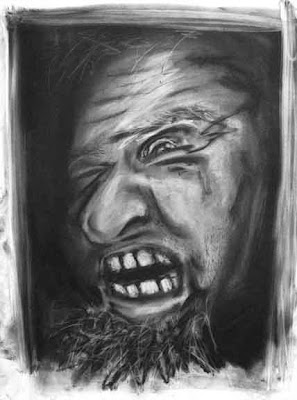 The second exercise involves two 20-minute sets of doing a value study with the still-life I set up the hour before class. Usually I’d recreate the standard boxes on the table and drape with fabric, but lacking the sheets I resorted to draping the boxes instead with rolls of newsprint, toilet paper and paper towels. This setup reinforces the importance of having an understanding of what the underlying structure is and how it affects the drapery, and involves a wee bit of linear perspective too. This is analogous to the study of anatomy for figure drawing, geology for landscapes etc. The students work up a simple section, isolating a few key folds, edges, shadows and planes (using the framing/cropping devise from the last class to select an interesting composition), again delineating the general, principle shapes with broad areas using the edge of a charcoal stump and eraser over a base tone, establishing the extremes of darks and highlights, then smoothing the transitions between with gradients with fingers and towel. Then a light coating of fixative is applied, allowed to dry, and then experimentation with the white Conte crayons to see what effect on creating blends and highlights this additional tool can achieve. For many, a second coating of fixative is applied and further reworking of the range of values is pushed back and highlights pulled out. This gives an absolute, clear example of what will be required in their assignment pieces, along with a
The second exercise involves two 20-minute sets of doing a value study with the still-life I set up the hour before class. Usually I’d recreate the standard boxes on the table and drape with fabric, but lacking the sheets I resorted to draping the boxes instead with rolls of newsprint, toilet paper and paper towels. This setup reinforces the importance of having an understanding of what the underlying structure is and how it affects the drapery, and involves a wee bit of linear perspective too. This is analogous to the study of anatomy for figure drawing, geology for landscapes etc. The students work up a simple section, isolating a few key folds, edges, shadows and planes (using the framing/cropping devise from the last class to select an interesting composition), again delineating the general, principle shapes with broad areas using the edge of a charcoal stump and eraser over a base tone, establishing the extremes of darks and highlights, then smoothing the transitions between with gradients with fingers and towel. Then a light coating of fixative is applied, allowed to dry, and then experimentation with the white Conte crayons to see what effect on creating blends and highlights this additional tool can achieve. For many, a second coating of fixative is applied and further reworking of the range of values is pushed back and highlights pulled out. This gives an absolute, clear example of what will be required in their assignment pieces, along with a Additionally, while the class is doing this I check everyone’s sketchbooks for the thumbs for the second assignment (the article of clothing) that’s due in one week (part of their weekend’s homework), and remind them of how the previous session’s exercises with the compositional thingy using a wad of toilet paper + the Fred Machetanz value study and how they both directly relate to today’s task. By now, some have quickly figured out exactly why there are no excused absences in this class as they will be at a distinct disadvantage if they miss even one day. One habitually late student was basically left behind today, as there was no possible way I was going to go over everything they had missed, especially for one person when there are fifteen others who are ready, waiting, and prepared – the students who deserve energy & attention are the ones that care enough to at least show up on time. Might sound rather heavy-handed, but there logistically just isn’t enough time to go around as it is, and I focus my efforts towards those who demonstrate their interest with their actions, starting with attendance.
Fifteen minutes before the end of class, there’s a brief review of the work done today; comparison and contrast with what works, what doesn’t and why, announcements, early warning on what will be needed for Thursday’s exercise, and breakdown of the still-life while they clean the tables out of consideration for the incoming class. Afterwards a check-up on the BFA student’s final countdown to his opening next week, and drop off the two freelance gigs from last week to the respective clients for payment. Couple hours are spent mulling over some doodles in the sketchbook, creative juices inspired by a quadruple-shot mocha.
“I tell young people that the greatest paintings in museums are made with minerals mixed in oil smeared on cloth with the hair from the back of a pig's ear. It's that simple.” - James Rosenquist
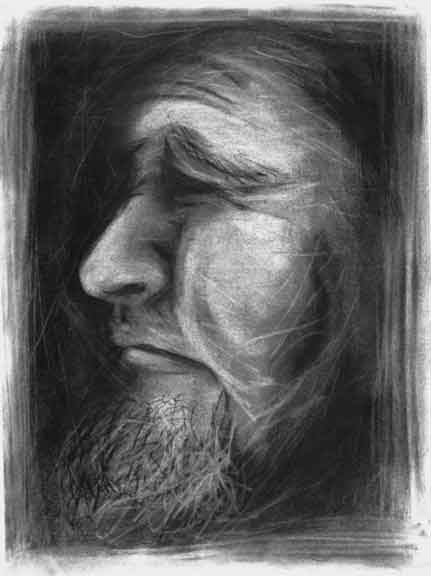


No comments:
Post a Comment